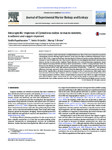Intra-specific responses of Cymodocea nodosa to macro-nutrient, irradiance and copper exposure
| dc.contributor.author | Papathanasiou, V | en |
| dc.contributor.author | Orfanidis, S | en |
| dc.contributor.author | Brown, MT | en |
| dc.date.accessioned | 2015-12-10T13:52:33Z | |
| dc.date.available | 2015-12-10T13:52:33Z | |
| dc.date.issued | 2015-08-01 | en |
| dc.identifier.issn | 0022-0981 | en |
| dc.identifier.uri | http://hdl.handle.net/10026.1/3914 | |
| dc.description.abstract |
Excess macro-nutrients, metal contamination and light limitation are three of the most commonly encountered anthropogenic stressors affecting seagrass meadows. In this study, the effects of different combinations of nutrients (N-NO<inf>3</inf>, P-PO<inf>4</inf>), copper and irradiance were investigated in shoots of Cymodocea nodosa collected from three meadows in the N. Aegean Sea, one (Nea Karvali) impacted by anthropogenically-derived environmental stressors and two in more pristine condition (Thasos, Brasidas). In a series of laboratory experiments, shoots were exposed to varying nutrient and heavy metal concentrations, as well as varying irradiance levels, for 8days and the effective quantum yield (δF/Fm') and leaf elongation were quantified. Results showed that C. nodosa increased δF/Fm' under high nutrient concentrations (30μΜ N-NO<inf>3-</inf>-2μΜ P-PO<inf>4</inf><sup>3-</sup>) but significant differences were only apparent in shoots collected from the oligotrophic-less stressed meadows. Irradiance affected δF/Fm' significantly in all shoots irrespective of source and PO<inf>4</inf>-P concentration, while higher values were measured under low light conditions and it was identified as the main pathway of eutrophication stress in N. Aegean Cymodocea meadows. Shoots, independently of acclimation were tolerant to copper enrichment, with only the highest copper concentrations (4.7 and 7.9μM) having significant negative effects on δF/Fm'. Shoots from the more pristine meadows were less affected by Cu than those from the highly stressed meadow. | en |
| dc.format.extent | 113 - 122 | en |
| dc.language.iso | en | en |
| dc.title | Intra-specific responses of Cymodocea nodosa to macro-nutrient, irradiance and copper exposure | en |
| dc.type | Journal Article | |
| plymouth.volume | 469 | en |
| plymouth.publication-status | Published | en |
| plymouth.journal | Journal of Experimental Marine Biology and Ecology | en |
| dc.identifier.doi | 10.1016/j.jembe.2015.04.022 | en |
| plymouth.organisational-group | /Plymouth | |
| plymouth.organisational-group | /Plymouth/Faculty of Science and Engineering | |
| plymouth.organisational-group | /Plymouth/REF 2021 Researchers by UoA | |
| plymouth.organisational-group | /Plymouth/REF 2021 Researchers by UoA/UoA06 Agriculture, Veterinary and Food Science | |
| plymouth.organisational-group | /Plymouth/Research Groups | |
| plymouth.organisational-group | /Plymouth/Research Groups/Marine Institute | |
| dc.rights.embargoperiod | 12 months | en |
| rioxxterms.versionofrecord | 10.1016/j.jembe.2015.04.022 | en |
| rioxxterms.licenseref.uri | http://www.rioxx.net/licenses/under-embargo-all-rights-reserved | en |
| rioxxterms.type | Journal Article/Review | en |


